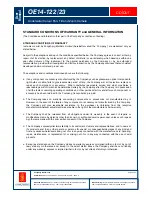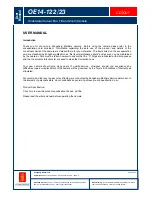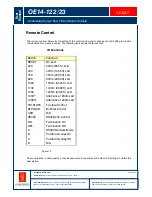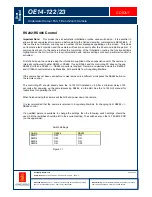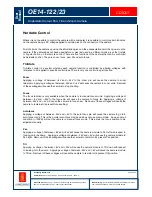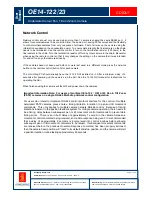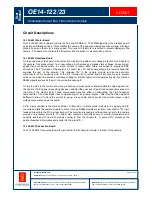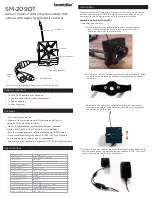
JBA Explorer.lnk
OE14-122/23
Underwater Colour Pan, Tilt and Zoom Camera
colour
U
ser
Ma
nua
l
Manufacturing:
Airport Industrial Estate, Wick, Caithness, Scotland
tel:
+44 (0)1955 603606
fax:
+44 (0)1955 607520
Sales and Service:
Campus 1, Science and Technology Park, Aberdeen, Scotland
tel:
+44 (0)1224 226500 (24 hrs)
fax:
+44 (0)1224 226501
Kongsberg Maritime Ltd
User Manual:
OE14-122 Colour Pan, Tilt and Zoom Camera - 5023 –5
Page 12 of 14
Circuit Descriptions
14-122-6011 Motor Board
The 14-122-6011 Motor Board controls the Pan and Tilt Motor’s. The PWM signal from the interface board
goes into an H-Bridge Circuit. This amplifies the power of the signal and increases drive voltage. H-Bridge
gives full power to the motor’s at any speed. The current to the motor’s is limited to prevent damage to the
camera. The board also contains the IR receiver and the sensor to measure Pan position.
14-122-6012 Interface Board
On the underside of the board is the protection circuitry it provides over voltage protection for all inputs to
the camera. Transorbs protect from over-voltage, both spikes and steady state voltages. Fuses protect
against fault conditions where too much current is drawn. EMC filters are added to suppress EMC
emissions. The 2
nd
purpose of the board is to convert the 16V- 24V supply voltage to a lower voltage that
supplies the rest of the circuitry. This includes 12V to the camera module and some electronic
components, 5V for powering most of the IC’s, Isolated 5V to isolate some input circuitry as to prevent
noise on the video line and as a reference voltage for tri-state operation. It separates tri-sate, bi-polar and
RS485 signals and sends them to the correct processing IC.
On the top side is the control and video processing circuitry process and amplifies the video signal from
the camera. If a long line drive setting has been selected then a series of resistors and capacitors are put in
the path of the video signal. These components have the affect of attenuating the high frequency
components of the video signal thus compensating for long cable lengths. After this the video signal is
buffered to allow it to have the current to go up a long cable and to protect the circuits incase a high
voltage spike comes down the cable.
A PIC microcontroller is the main controller. In Bi-polar or tri-state mode it reads in the signals via A/D
converts and tells the camera module to zoom or focus. RS485 signals are isolated, converted to TTL logic
levels and read into the PIC via its serial port. The command is read in and the action is sent to the camera
module or processed internally. The board also contains a humidity sensor to monitor temperature and
humidity levels and to deal with signals coming in from the IR remote. A second PIC processes the
position feedback information and sends it to the main PIC>
14-122-6013 Connection Board
The 14-122-6013 Connection Board is just used to link the camera module to the rest of the camera.


